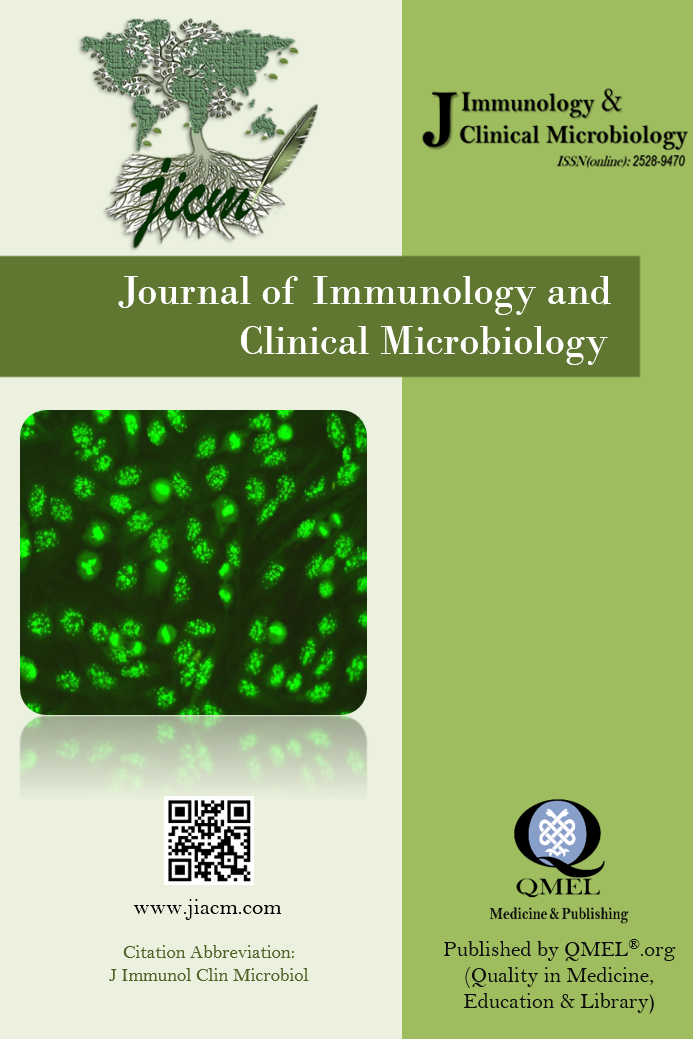High Eosinophilia Strongly Associated with Human Toxocariasis
High Eosinophilia Strongly Associated with Human Toxocariasis
Toxocara spp., human toxocariasis,
___
- Azizi S, Oryan A, Sadjjadi SM, Zibaei M. Histopathologic changes and larval recovery of Toxocara cati in experimentally infected chickens. Parasitol Res. 2007; 102 (1): 47–52.
- Roldán WH, Espinoza YA, Atúncar A, Ortega E, Martinez A, Saravia M. Frequency of eosinophilia and risk factors and their association with Toxocara infection in schoolchildren during a health survey in the north of Lima, Peru. Rev Inst Med Trop Sao Paulo. 2008; 50(5):273-278.
- Magnaval JF, Glickman LT, Dorchies P, Morassin B. Highlights of human toxocariasis. Korean J Parasitol. 2001; 39(1):1-11.
- Zibaei M, Sadjjadi SM. Trend of toxocariasis in Iran: a review on human and animal dimensions. Iran J vet Res. 2017; 18(4): 233-242.
- Öge H, Öge S, Özbakış G, Gürcan S. Comparison of Toxocara eggs in hair and faecal samples from owned dogs and cats collected in Ankara, Turkey. Vet Parasitol. 2014; 206(3-4):227-31.
- Cooper PJ, Alexander N, Moncayo AL, Benitez SM, Chico ME, Vaca MG, Griffin GE. Environmental determinants of total IgE among school children living in the rural Tropics: importance of geohelminth infections and effect of anthelmintic treatment. BMC Immunol. 2008; 27:9:33.
- Dattoli VC, Freire SM, Mendonça LR, Santos PC, Meyer R, Alcantara-Neves NM. Toxocara canis infection is associated with eosinophilia and total IgE in blood donors from a large Brazilian centre. Trop Med Int Health. 2011; 16(4):514-7.
- Iddawela D, Ehambaram K, Atapattu D, Pethiyagoda K, Bandara L. Frequency of Toxocariasis among Patients Clinically Suspected to Have Visceral Toxocariasis: A Retrospective Descriptive Study in Sri Lanka. J Parasitol Res. 2017; 4368659.
- Mohamad S, Azmi NC, Noordin R. Development and evaluation of a sensitive and specific assay for diagnosis of human toxocariasis by use of three recombinant antigens (TES-26, TES-30USM, and TES-120). Clin Microbiol 2009; 47(6): 1712-7.
- Yamasaki H, Araki K, Lim PK, et al. Development of a highly specific recombinant Toxocara canis second-stage larva excretory-secretory antigen for immunodiagnosis of human toxocariasis. J Clin Microbiol 2000; 38(4): 1409-13.
- Perteguer MJ, Cuéllar C, Guillén JL, et al. Cross-reactivity between Anisakis simplex sensitization and visceral larva migrans by Toxocara canis. Acta Trop 2003; 89(1): 85-9.
- Rodero M, Chivato T, Muro A, Cuéllar C. Enzyme-linked immunosorbent assay and Western blot antibody determination in sera from patients diagnosed with different helminthic infections with Anisakis simplex antigen purified by affinity chromatography. Mem Inst Oswaldo Cruz 2005; 100(3): 293-301.
- Jacquier P, Gottstein B, Stingelin Y, Eckert J. Immunodiagnosis of toxocarosis in humans: evaluation of a new enzyme-linked immunosorbent assay kit. Clin Microbiol 1991; 29(9): 1831-5.
- Korkmaz M. Visceral larva migrans. İkinci evre Toxocara canis larvalarının in vitro kültürü, ekskretuvar/sekretuvar antijenin elde edilmesi ve ELISA yöntemi ile tanısı (Uzmanlık tezi). Ege Üniversitesi Tıp Fakültesi, Parazitoloji Anabilim Dalı, İzmir. (1998).
- Schägger H1, von Jagow G. Tricine-sodium dodecyl sulfate-polyacrylamide gel electrophoresis for the separation of proteins in the range from 1 to 100 kDa. Anal Biochem. 1987 Nov 1;166(2):368-79.
- Magnaval JF, Fabre R, Maurières P, Charlet JP, de Larrard B. Application of the western blotting procedure for the immunodiagnosis of human toxocariasis. Parasitol Res. 1991;77(8):697-702.
- Sözen H, Citil BE, Caylak S, Gokmen AA, Kaya S, Demirci M, Korkmaz M, Sahin C, Kirli I. Seroepidemiological Study of Toxocariasis among Volunteers Animal Husbandry Workers and Veterinary in Southern Anatolia in Turkey in 2014. Iran J Parasitol. 2015; 10(3):473-81.
- Yazar S, Yaman O, Cetinkaya U, Hamamci B, Sahin I. Investigation of anti-Toxocara canis IgG antibodies in patients presenting at The Erciyes University Medical Faculty, Department of Parasitology. Turkiye Parazitol Derg. 2010; 34(1):24-26.
- Doğan N, Dinleyici EC, Bor O, Töz SO, Ozbel Y. Seroepidemiological survey for Toxocara canis infection in the northwestern part of Turkey. Turkiye Parazitol Derg. 2007; 31(4):288-91.
- Büyükbaba Ö, Özkan E, Büget E. Toxocara canis ve çocuklardaki prevalansının ELISA ile araştırılması. İnfeksiyon Derg. 1996; 10(1): 7-11.
- Kwon NH, Oh MJ, Lee SP, Lee BJ, Choi DC. The prevalence and diagnostic value of toxocariasis in unknown eosinophilia. Ann Hematol. 2006; 85(4):233-8.
- Demirci M, Kaya S, Cetin E, Arıdoğan B, Onal S, Korkmaz M. Seroepidemiological investigation of toxocariasis in the isparta region of Turkey. Iran J Parasitol. 2010; 5(2):52-59.
- Kim HB, Seo JW2, Lee JH2, Choi BS3, Park SG2. Evaluation of the prevalence and clinical impact of toxocariasis in patients with eosinophilia of unknown origin. Korean J Intern Med. 2017; 32(3):523-529.
- Maraghi S, Rafiei A, Hajihossein R, Sadjjadi SM. Seroprevalence of toxocariasis in hypereosinophilic individuals in Ahwaz, south-western Iran. J Helminthol. 2012; 86(2): 241-244.
- Yayın Aralığı: Yılda 4 Sayı
- Başlangıç: 2016
- Yayıncı: Erkan YULA
Selçuk KAYA, Mehmet KARABEY, Serdar GÜNGÖR, Nurten BARAN, Aslı Gamze ŞENER, İlhan AFŞAR
Routine Surgical Drainage in Tubo-ovarian Abscess: Single Center Experience with Fifty Patients
Aysu AKCA, Gulseren YİLMAZ, Nevin TUTEN, Berna ASLAN CETİN
High Eosinophilia Strongly Associated with Human Toxocariasis
Ayşegül AKSOY GÖKMEN, Aylin BABAOĞLU, Bayram Pektaş PEKTAŞ, Selçuk KAYA, Derya DİRİM ERDOĞAN, Metin KORKMAZ
Investigation of hospital-acquired infections in units other than the intensive care unit
Şebnem ÇALIK, Alpay ARI, Bengisu AY, Özlem Yüksel ERGİN, Selma TOSUN
Meme Kanserinin Palpable Olması veya Palpe Edilmemesinin Prognostik ve Prediktif Değeri
